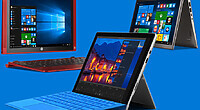
Legacy publishers often view e-books as simply as another distribution channel for selling their print books. There have been a number of digital initiatives lately that buck this trend and give readers a different experience.
Last month Apple teamed up with J.K. Rowling and Pottermore for a new immersive experience for all 7 books in the Harry Potter series.
The new enhanced editions are available exclusively through the Apple iBooks store. It offers readers more than 200 illustrations, animations, interactive images and annotations from J.K. Rowling herself. The original digital versions were previously only available through the Pottermore Shop.
The enhancements are subtle, but offer an expanded imagination to certain scenes. For example, Aunt Marge will float on the page after Harry blows her up like a balloon, and readers can select which winged key to use while on the hunt for the Sorcerer’s stone with Harry, Ron and Hermione. An interactive Quidditch match will make it harder to decide what’s more fun: trying to catch the golden snitch or simply turning the page. And Molly Weasley’s infamous Howler explodes out of the text during breakfast in the Great Hall.
The Orient Express History by Arjan den Boer is another great example of what can be done when the author/publisher chooses to create their eBook as an app. This iOS exclusive gives readers a sense of the overall history of the Express, from the far east to Milan and Budapest and Istanbul.
“I created this app mainly for myself, to compile all the knowledge and the material I have collected, actually making a kind of product out of it. At the same time, I think it will appeal to people interested in the history of luxury travel, the whole atmosphere of grand hotels and stations — but also to design enthusiasts, because the app showcases many beautiful posters and brochures, and railway station architecture as well.”

Scholarly knowledge dissemination has also entered the 21st century thanks to enhanced e-books.
The author cites his reasoning for going in this direction “A traditional print book (along with the conventional e-book versions that replicate them) has two layers: the main body and a thin stratum of footnotes and endnotes. The enhanced e-book can display multiple narratives or voices, each speaking to a different audience. One might compare this innovation to the page layout that Daniel Bomberg adopted in 1523 for Talmud editions—a running source text at the center surrounded by an array of commentaries.”
His new title includes audio and video clips at the ends of chapters. Readers can follow links to articles, books, websites, and videos. They can annotate what they read, highlight lines in a palette of colors, and share them via email and social media.
One of the best aspects of enhanced e-books is that it can finally solve the endemic problems posed by academics who want to show their colleagues how they arrived at their conclusions, but also want to make their work appealing to readers beyond their discipline.
Michael Kozlowski is the editor-in-chief at Good e-Reader and has written about audiobooks and e-readers for the past fifteen years. Newspapers and websites such as the CBC, CNET, Engadget, Huffington Post and the New York Times have picked up his articles. He Lives in Vancouver, British Columbia, Canada.
